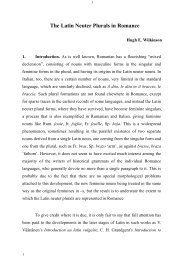THE STRONG PERFECTS IN THE ROMANCE ... - Page ON
THE STRONG PERFECTS IN THE ROMANCE ... - Page ON
THE STRONG PERFECTS IN THE ROMANCE ... - Page ON
You also want an ePaper? Increase the reach of your titles
YUMPU automatically turns print PDFs into web optimized ePapers that Google loves.
tin(g), tenis, tint, and vin(g), venis, vint etc. (ting, ving, like voil, with<br />
palatalisation before a following vowel), with other forms like tensis,<br />
vensis (this time to be referred to the action of prendre, which has prensis),<br />
EFr. tenui, venust, NFr. tinve, vinve (with development as in the adj.<br />
tenv(r)e from tenuis). The parallelism between the forms must mean that<br />
tenui and vēni influenced each other, producing the pairs *tēnui/*tēni and<br />
*vēnui/vēni (the long e’s being required to produce the i’s in French). As<br />
we have seen, Latin has examples of forms with and without u for both<br />
verbs, and vin(g), vinve, at least, can be traced directly back to them, so we<br />
do not have the problem of speculating what happened to the u. Once again,<br />
French keeps the paradigms with and without u separate. Here Dardel, in<br />
quoting as usual the contrast between ting, “dont la voyelle a été influencée<br />
par celle de 1 ving”, and tenis, does not explain whether he thinks ting<br />
comes from *tēnni < tēnui, but evidently wishes to convey this impression;<br />
if so, then I would counter that by the same token tenis should come from<br />
*tēnnisti < tēnuisti. (For another parallel to EFr. tenui, venust see semonui<br />
under the -si perfects below, §31, which may go back to Lat. submonui.)<br />
Paroir gives parui, parus, paru(t) etc. and p.p. paru/pareü, and<br />
courre follows the same conjugation. It will be seen that in French this<br />
conjugation is typical of the stems ending in a liquid or nasal<br />
(criembre/cremoir similarly has cremui, p.p. cremu), and from the point of<br />
view of French alone it may be said that these weak perfects were formed<br />
under the influence of the p.ps. (this would seem to be the natural<br />
explanation of the regional developments voulu(s) (later to become the<br />
standard), tenui, venust), aided by the weak forms like oüs, poüs and also,<br />
perhaps, by fui, fus, fut (see below, §32). But when one looks at the -rere<br />
verbs (parēre, currere, quaerere) in Provençal, Gascon and Catalan, one is<br />
struck by the fact that they have developed special forms as Prov. parec,<br />
correc, querec, with corresponding p.ps. paregut/parut, corregut, queregut<br />
24









